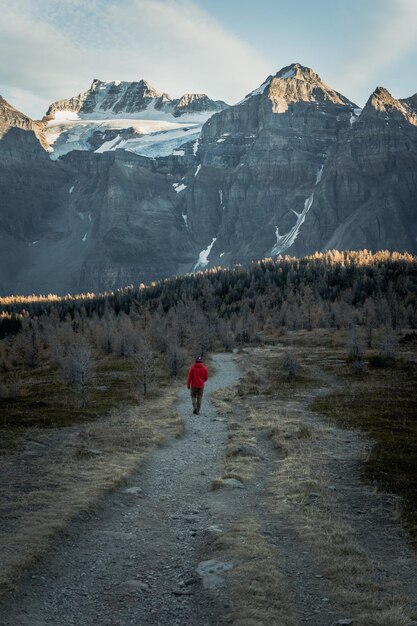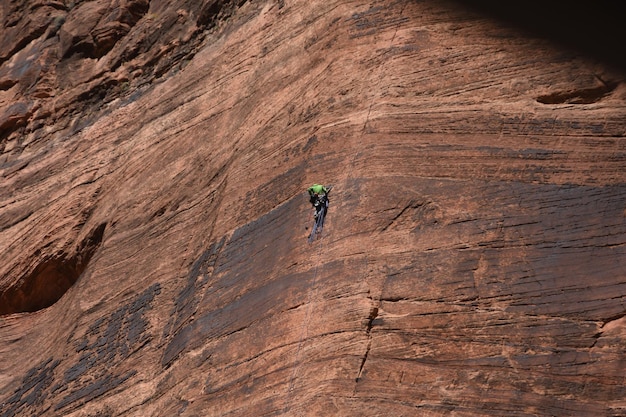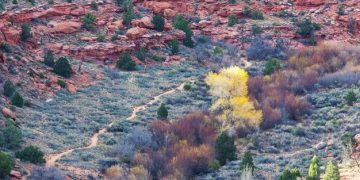The Adventurer’s Guide to the US: Hiking, Biking, and Climbing Destinations for 2025

The Adventurer’s Guide to the US: Hiking, Biking, and Climbing Destinations for 2025 highlights top outdoor locations across the United States, offering diverse experiences for enthusiasts seeking unparalleled natural beauty and thrilling challenges.
Embarking on outdoor adventures across the United States offers an unparalleled journey into the heart of nature’s grandeur. This Adventurer’s Guide to the US: Hiking, Biking, and Climbing Destinations for 2025 aims to illuminate the most captivating and challenging locales, inviting enthusiasts to explore the vast natural playgrounds our nation provides.
The Lure of the Wild: Why 2025 is Your Year for US Adventures
The spirit of exploration is an enduring human trait, a primal urge to discover what lies beyond the familiar. In 2025, the United States stands as an unrivaled canvas for those yearning to answer this call, offering an extraordinary mosaic of landscapes that cater to every level of outdoor enthusiast. From the rugged peaks that pierce the sky to the winding trails that weave through ancient forests and the sheer rock faces that challenge the most seasoned climbers, the sheer diversity is breathtaking.
The appeal of these destinations extends beyond mere physical challenge; it resides in the profound connection forged with nature, the clarity found in solitude, and the camaraderie built through shared experiences. Whether it’s the thrill of conquering a challenging ascent, the meditative rhythm of a long-distance bike ride, or the quiet awe inspired by a pristine wilderness hike, each adventure leaves an indelible mark. This is not just about visiting places; it’s about immersing oneself in environments that test resilience, deepen appreciation for ecological balance, and offer a powerful sense of accomplishment.
Embracing the Call of the Outdoors
For many, the routine of daily life can dull the senses, but the outdoors offers an immediate antidote. The vastness of the American landscape ensures that there’s always a new vista to behold, a different challenge to overcome. The allure for 2025 is particularly strong as communities continue to embrace outdoor recreation, with improved infrastructure and resources for adventurers of all stripes. This growing emphasis on sustainable tourism also means that many of these natural treasures are being preserved with greater care, ensuring their majesty for future generations. It’s an invitation to step away from the digital noise and reconnect with the tangible world.
- Unrivaled natural beauty across diverse biomes.
- Opportunities for physical and mental rejuvenation.
- Connection with like-minded outdoor communities.
- Accessibility to varying levels of adventure, from novice to expert.
As we look to 2025, the motivation to explore becomes even more compelling. The call of the wild echoes louder, promising both solace and excitement. It’s a chance to escape, to challenge personal limits, and to witness the raw, untamed beauty that only North America can offer. Preparing for these expeditions involves more than just packing gear; it means cultivating a mindset of openness, respect for the environment, and a readiness for the unexpected. These journeys are not merely vacations but transformative experiences that resonate long after the boots are cleaned and the gear is stowed away.
Peak Performance: Premier Hiking Trails for 2025
The United States boasts an unparalleled network of hiking trails, each offering a unique narrative carved by geological forces and natural beauty. From the iconic long-distance paths that traverse multiple states to shorter, intensely scenic day hikes, the options for 2025 are abundant. These trails are not just routes; they are gateways to understanding the diverse ecosystems of America, offering challenges that range from gentle strolls to arduous ascents that test stamina and spirit.
For serious trekkers, classic destinations remain at the forefront. The Appalachian Trail, stretching over 2,000 miles from Georgia to Maine, offers a profound thru-hiking experience, though sections can be enjoyed for shorter, equally rewarding journeys. Its rugged beauty and historical significance make it a perennial favorite. Similarly, the Pacific Crest Trail, extending from Mexico to Canada through California, Oregon, and Washington, presents diverse climates and awe-inspiring vistas, from arid deserts to alpine wilderness. These long trails symbolize the ultimate hiking challenge, demanding months of dedication and meticulous planning.
Hidden Gems and Regional Favorites
Beyond the well-trodden paths, numerous regional trails offer equally compelling experiences without the same level of commitment. In the Northeast, areas like the Adirondack High Peaks in New York provide challenging summits with panoramic views, while New Hampshire’s White Mountains, home to Mount Washington, offer a mix of strenuous climbs and accessible ridge walks. The autumn foliage in these regions transforms the trails into a vibrant tapestry, making them particularly popular during the fall. Proper preparation for variable weather, especially in higher elevations, is crucial for an enjoyable and safe hike.
Moving westward, the national parks are treasure troves of hiking opportunities. Yellowstone’s backcountry trails offer unique encounters with geysers and wildlife, while Zion National Park in Utah provides dramatic slot canyon hikes, like the famous Narrows, where adventurers wade through water between towering sandstone walls. The Grand Canyon’s rim-to-river trails, such as Bright Angel and South Kaibab, descend into one of the world’s most iconic geological formations, providing a deep dive into ancient landscapes.
- Appalachian Trail: Extended thru-hike or section hikes.
- Pacific Crest Trail: Diverse terrains from desert to forest.
- Adirondack High Peaks: Challenging summits in New York.
- Zion National Park: Unique slot canyon experiences.
- Grand Canyon: Iconic rim-to-river descents.
For those seeking solitude, exploring wilderness areas outside of the most famous national parks can yield incredible rewards. National Forests often contain extensive trail systems that are less crowded but equally stunning. For instance, the Ansel Adams Wilderness in California or the Bob Marshall Wilderness in Montana offer true backcountry experiences, often requiring advanced navigation skills but delivering unmatched tranquility and untouched nature. Always check local regulations, obtain necessary permits, and practice Leave No Trace principles when venturing into these pristine environments. The hiking landscape of the US in 2025 promises routes for every dream, from the gentle to the truly grand.
Pedal Power: Epic Biking Routes for Every Cyclist in 2025
The United States offers a formidable array of biking routes, catering to every style of cyclist, from the casual rider seeking scenic paths to the hardcore mountain biker craving adrenaline-pumping descents. In 2025, the growth in dedicated bike paths, improved infrastructure, and the expansion of bike-friendly communities make it an ideal year to explore the nation on two wheels. These routes not only provide exceptional physical activity but also offer unique ways to experience the diverse landscapes and hidden gems that might be missed from a car window.
For road cyclists, scenic byways and dedicated bike routes are plentiful. The Natchez Trace Parkway, stretching 444 miles from Natchez, Mississippi, to Nashville, Tennessee, offers a continuous ride with no commercial traffic, gentle hills, and historic sites. It’s a serene journey through picturesque Southern landscapes. Another classic is the Hiawatha Trail in Montana and Idaho, a mostly downhill rail-trail that features numerous tunnels and trestles, making it particularly popular for families and those seeking a less strenuous ride through stunning mountainous terrain. Many cities also boast expansive greenway systems, like those in Minneapolis or Portland, providing urban and suburban riders safe and accessible cycling environments.
Mountain Biking Havens and Gravel Grinding Adventures
When it comes to mountain biking, the options are world-class. Moab, Utah, remains an iconic destination, famous for its slickrock trails that offer incredible grip and challenging technical features amidst dramatic desert scenery. From the iconic Slickrock Trail to the more accessible Dead Horse Point State Park trails, Moab provides a diverse range of experiences. Further west, the Pacific Northwest, particularly regions around Bend, Oregon, and Whistler (though technically in Canada, it’s a short drive from the US border and a major draw), are renowned for their extensive networks of singletrack trails, catering to all skill levels with lush forests and stunning mountain backdrops.

Gravel biking, a rapidly growing discipline, finds its perfect habitat in the vast network of unpaved roads and backcountry trails across the US. The Mid-Atlantic offers routes like the C&O Canal Towpath, a largely flat, historic gravel path running from Washington D.C. to Cumberland, Maryland, providing a multi-day journey through Civil War battlefields and natural beauty. In the Midwest, Kansas and Iowa are surprisingly popular for their endless miles of gravel roads, hosting major endurance events and offering peaceful, rolling agricultural landscapes. These routes blend the adventure of mountain biking with the covering of significant distances characteristic of road cycling, making them versatile options for exploration.
- Moab, Utah: Renowned slickrock trails for technical mountain biking.
- Natchez Trace Parkway: Serene road cycling through historic landscapes.
- Bend, Oregon: Extensive singletrack for all mountain biking levels.
- C&O Canal Towpath: Historic gravel route in the Mid-Atlantic.
- Kansas and Iowa gravel roads: Ideal for long-distance gravel grinding.
Preparing for biking adventures in 2025 involves choosing the right bike for the terrain, whether it’s a road bike, mountain bike, or gravel bike, and ensuring it’s in top condition. Safety gear, including a helmet, lights, and appropriate clothing, is essential. Additionally, understanding the local trail conditions and rules, especially in wilderness areas or national parks, is paramount for a respectful and enjoyable ride. The US cycling scene in 2025 offers a dynamic and expanding world of exploration, inviting cyclists to pedal their way through some of the most stunning landscapes imaginable.
Scaling New Heights: Top Climbing Destinations for 2025
For those drawn to the vertical world, the United States offers some of the most iconic and diverse climbing destinations on the planet. From granite big walls to sandstone towers and limestone Sport routes, 2025 promises an array of challenges for every level of climber. These areas not only provide world-class rock but also serve as vibrant hubs where climbing communities thrive, sharing knowledge, techniques, and the sheer joy of ascent.
Yosemite Valley in California remains the undisputed mecca for big wall climbing. Its majestic granite formations, including El Capitan and Half Dome, have inspired generations of climbers with their immense scale and historical significance. While multi-day ascents of these titans require expert skills and extensive preparation, Yosemite also offers incredible opportunities for single-pitch sport climbing and traditional routes on smaller formations. The sheer grandeur of the valley itself is an experience, regardless of one’s climbing objectives.
Diverse Rock, Diverse Challenges
Outside of Yosemite, diverse rock types offer varied climbing experiences. New River Gorge National Park in West Virginia is celebrated for its sandstone cliffs, boasting thousands of sport climbing routes, often steep and powerful. This area has gained significant popularity due to its diverse grades, excellent rock quality, and accessibility, making it a prime destination for sport climbers from across the country. The New, as it’s affectionately known, offers routes suitable for beginners to pros.
Another incredible, though vastly different, destination is the Red River Gorge in Kentucky. This region, also in Appalachia, features extensive pockets and massive overhangs of sandstone, providing some of the best sport climbing in the world, especially for those who love steep, powerful movements. The climbing culture here is incredibly welcoming, and the sheer volume of routes ensures that every visit reveals new challenges.
- Yosemite National Park: World-class big wall and traditional climbing.
- New River Gorge: Extensive sport climbing on sandstone.
- Red River Gorge: Steep sport climbing with unique sandstone features.
- Joshua Tree National Park: Desert crack and traditional climbing.
- Rocky Mountain National Park: Alpine rock and ice climbing.
For traditional climbing, Joshua Tree National Park in California is a unique desert playground. Its monzogranite formations offer classic cracks, slabs, and face climbs amidst an otherworldly landscape of bizarrely shaped Joshua trees and massive boulders. The climbing here is often technical and requires a good grasp of traditional protection. In contrast, the high-altitude environments of the Rocky Mountains, particularly areas in Colorado like Rocky Mountain National Park, provide alpine rock and ice climbing opportunities, often requiring specific skills in multi-pitch and exposed terrain, combined with an understanding of mountain weather patterns.
Regardless of the chosen destination, safety is paramount. This includes thorough route planning, understanding local conditions, carrying appropriate gear, and ideally, climbing with experienced partners. Local guides and climbing schools are excellent resources for those looking to develop their skills or explore new areas safely. The climbing scene in the US for 2025 is dynamic and inviting, offering vertical adventures that promise not just physical challenge but unparalleled views and a deep sense of connection to the rock beneath one’s fingertips.
Planning Your 2025 Adventure: Essential Gear and Safety
Successful outdoor adventures are built on meticulous planning, with essential gear and safety protocols forming the bedrock of any expedition. For those embarking on hiking, biking, or climbing trips across the US in 2025, understanding what to pack and how to mitigate risks can make the difference between a memorable experience and a challenging ordeal. Prioritizing safety through preparation is not just a recommendation; it’s a necessity.
For hiking, the “ten essentials” (navigation, headlamp, sun protection, first aid, knife, fire starter, shelter, extra food, extra water, extra clothes) are a time-honored checklist for good reason. Beyond these, comfortable, broken-in hiking boots are paramount, as are layered clothing options to adapt to changing weather conditions. A well-fitted backpack, capable of carrying all your supplies, is also crucial. For longer treks, considering a water filtration system, portable stove, and lightweight tent will enhance comfort and self-sufficiency. Always check the weather forecast for your specific destination and elevation changes before heading out.
Biking Gear and Trail Etiquette
Biking, whether road, mountain, or gravel, necessitates its own specific set of gear. A properly fitted helmet is non-negotiable, offering critical head protection. Beyond the bike itself, essential tools like a spare tube, tire levers, a pump, and a multi-tool are crucial for trailside repairs. Appropriate cycling apparel, including padded shorts and moisture-wicking jerseys, can greatly enhance comfort on long rides. For mountain biking, additional protective gear such as gloves, knee pads, and elbow pads are advisable, especially on technical trails. Understanding local trail etiquette, which often includes yielding to hikers and horses, and staying on marked trails, is key to a harmonious outdoor experience.

Climbing, by its nature, demands the most specialized and rigorously inspected gear. This includes a harness, climbing shoes, belay device, locking carabiners, and the appropriate ropes for the type of climbing (single, half, or twin). For traditional climbing, a “rack” of cams and nuts is essential, while sport climbing relies on quickdraws. A helmet is absolutely critical in all climbing disciplines to protect against rockfall and impacts. Regular inspection of all gear for wear and tear is vital. Investing in quality gear from reputable brands is highly recommended, as your life literally depends on it.
- Hiking: The Ten Essentials, well-fitted boots, layered clothing.
- Biking: Helmet, repair kit, appropriate cycling attire, protective pads for MTB.
- Climbing: Harness, shoes, belay device, ropes, protective gear (cams/nuts/quickdraws), helmet.
- Navigation: GPS device or app, physical map, compass.
- Communication: Satellite messenger or fully charged phone.
Regardless of the activity, a well-thought-out first-aid kit is indispensable, tailored to the potential injuries of the sport. Knowledge of basic first aid and wilderness medicine can be life-saving. Communication devices, such as a fully charged cell phone or, for remote areas, a satellite messenger or personal locator beacon, are vital for emergencies. Always inform someone of your itinerary and expected return time. Checking for permits, understanding land-use regulations, and practicing Leave No Trace principles—packing out everything you pack in—ensures these incredible natural spaces remain pristine for years to come. Planning is the adventure before the adventure.
Responsible Adventure: Leave No Trace Principles in 2025
As the popularity of outdoor recreation continues to surge, particularly as we look towards 2025, the imperative to engage in responsible adventure has never been greater. The “Leave No Trace” principles are the foundational guidelines for minimizing our impact on the natural world, ensuring that these pristine environments remain accessible and healthy for future generations. Adhering to these seven core principles is not just a suggestion; it’s a moral obligation for every adventurer.
The first principle, “Plan Ahead and Prepare,” emphasizes the importance of thorough preparation. This includes researching the area, knowing regulations and special concerns, packing appropriate gear, and preparing for extreme weather, hazards, and emergencies. Proper planning minimizes the need for on-the-fly fixes that could lead to environmental damage or safety issues. This foresight also reduces the likelihood of crowded conditions by encouraging off-peak visits or alternative routes, thereby lessening overall impact.
Minimizing Impact and Respecting Wildlife
“Travel and Camp on Durable Surfaces” is key to protecting fragile ecosystems. Stick to established trails and campsites, walk in single file in the middle of the trail, and avoid trampling vegetation. When camping, use existing designated sites whenever possible. If in undeveloped areas, choose sites that are at least 200 feet from water sources and trails, and minimize disturbance to the site. The goal is to leave no physical evidence of your presence.
“Dispose of Waste Properly” means packing out everything you pack in, including all trash and food scraps. “Pack it in, pack it out” is the golden rule. This also extends to human waste; burying solid human waste in catholes 6-8 inches deep and at least 200 feet from water, camp, and trails is essential, as is packing out toilet paper. Proper disposal prevents pollution and the spread of pathogens.
- Plan Ahead and Prepare: Research, pack right, expect conditions.
- Travel and Camp on Durable Surfaces: Stick to trails, use established sites.
- Dispose of Waste Properly: Pack out all trash, bury human waste.
- Leave What You Find: Preserve natural objects and artifacts.
- Minimize Campfire Impacts: Use existing rings, use small wood, fully extinguish.
- Respect Wildlife: Observe from a distance, never feed animals.
- Be Considerate of Other Visitors: Share trails, keep noise down.
“Leave What You Find” encourages adventurers to appreciate natural objects and cultural artifacts as they are, without altering or taking them. This means no picking wildflowers, no collecting rocks, and no disturbing historical sites. “Minimize Campfire Impacts” advocates for using existing fire rings, keeping fires small, and fully extinguishing them. In many areas, especially during dry conditions, campfires may be prohibited, and a small camp stove is a more responsible alternative.
“Respect Wildlife” is about observing animals from a distance, never feeding them, and understanding their behaviors. Feeding wildlife can harm their health, alter natural behaviors, and expose them to predators. Secure food and trash from animals at all times. Finally, “Be Considerate of Other Visitors” promotes a positive outdoor experience for everyone. This includes yielding to hikers and horses on trails, keeping noise levels down, and respecting the solitude and quiet enjoyment of others. Embracing these principles ensures that the incredible landscapes of the US remain vibrant and wild for collective enjoyment, both now and in 2025 and beyond.
Highlighting Regional Gems: Beyond the Tourist Traps in 2025
While iconic national parks like Yosemite, Zion, and Yellowstone rightfully draw millions, the United States is replete with countless regional gems that offer equally stunning outdoor experiences, often with fewer crowds. For the discerning adventurer in 2025, exploring these lesser-known, yet equally magnificent, destinations can provide a more intimate and profound connection with nature. These areas often offer a unique blend of local culture, untouched wilderness, and challenging terrain that caters to specific interests in hiking, biking, and climbing.
In the Pacific Northwest, beyond the well-trodden trails of Mount Rainier, consider exploring the Olympic National Park in Washington. Here, temperate rainforests, rugged coastlines, and alpine peaks converge to offer an incredibly diverse hiking landscape within a single park. The Hoh Rainforest offers unique, lush trails, while the Hurricane Ridge provides access to stunning mountain vistas. Biking possibilities along the coastline provide exhilarating views, and specific climbing routes in areas like the Enchantments are world-class, though often require permits and advanced skills. The varied ecosystems make it a truly unique destination for multi-sport adventurers.
Southeast’s Hidden Wonders and Midwest’s Unexpected Sanctuaries
The Southeast, often overlooked for its adventure potential, harbors significant outdoor treasures. While the Appalachian Trail captures headlines, areas like the Great Smoky Mountains National Park, straddling Tennessee and North Carolina, offer hundreds of miles of diverse hiking trails, from waterfall treks to dense forest paths. For climbers, the sandstone bluffs of the Obed Wild & Scenic River in Tennessee provide excellent traditional and sport climbing, boasting challenging routes without the massive crowds of other regions. Mountain biking trails are also rapidly developing in states like North Carolina, with places like Pisgah National Forest offering extensive networks for all skill levels.
The Midwest might not immediately conjure images of rugged adventure, but it holds surprising destinations. The Black Hills of South Dakota, for example, offer a remarkable blend of granite spires and pine forests. Here, you’ll find excellent climbing at the Needles of Custer State Park, providing unique spire climbing experiences. Hiking trails like those in Badlands National Park offer surreal landscapes and fascinating geological formations, while the Mickelson Trail provides a scenic and relatively flat gravel biking experience across the state, passing through quaint towns and historic sites. These unexpected havens prove that adventure can be found in every corner of the country, away from the typical tourist routes.
- Olympic National Park, WA: Rainforests, coastlines, alpine peaks.
- Obed Wild & Scenic River, TN: Sandstone climbing, less crowded.
- Black Hills, SD: Granite spires, unique climbing, historic trails.
- Superior Hiking Trail, MN: Long-distance trail along Lake Superior.
- Ozark National Forest, AR: Diverse trails, climbing, and biking.
For those seeking long-distance solitude, the Superior Hiking Trail along the North Shore of Lake Superior in Minnesota offers breathtaking views of the massive freshwater lake, traversing cliffs, forests, and river valleys. This region provides a distinct kind of rugged beauty, perfect for extended backpacking or thru-hiking sections. Similarly, the Ozark National Forest in Arkansas boasts scenic trails, rock formations, and pockets of wilderness perfect for a range of activities. Venturing into these regional gems in 2025 requires a slightly different approach; it’s about connecting with local communities, respecting unique ecosystems, and often, discovering the quiet magnificence that escapes the mainstream spotlight, ensuring a deeply personal and enriching adventure.
| Key Aspect | Brief Description |
|---|---|
| 🚶 Top Hiking Trails | Appalachian & Pacific Crest Trails for thru-hikers; Zion & Grand Canyon for iconic views. |
| 🚴 Epic Biking Routes | Moab for MTB, Natchez Trace for road cycling, vast gravel networks. |
| 🧗 Premier Climbing Spots | Yosemite’s big walls, New River Gorge & Red River Gorge for sport climbing. |
| 🗺️ Responsible Adventure | Embrace Leave No Trace principles for sustainable exploration. |
Frequently Asked Questions About US Outdoor Adventures
▼
The ideal time largely depends on the park and activity. Spring and fall generally offer milder temperatures and fewer crowds for hiking and climbing. Summer is popular but can be very hot in desert parks and crowded everywhere. Winter provides unique adventures like snowshoeing or ice climbing but requires specialized gear and experience.
▼
Many popular wilderness areas, especially within national parks, require permits for overnight backcountry stays or for certain high-demand activities like specific climbing routes or thru-hikes. Always check the official park or forest service website well in advance, as some permits are competitive and issued through a lottery system.
▼
Always inform someone of your itinerary and expected return. Carry the “Ten Essentials” (listed previously) for all hikes. Be aware of local wildlife and environmental hazards like extreme weather changes or venomous animals. For climbing, ensure all gear is inspected and you climb with experienced partners.
▼
Absolutely. Many national and state parks offer easy-to-moderate hiking trails. For biking, rail-trails like the Hiawatha or urban greenways are great starts. For climbing, areas like the Red River Gorge have numerous beginner-friendly sport routes, and many guide services offer introductory courses at popular crags.
▼
The core tenets are planning, staying on durable surfaces, properly disposing of waste (pack it in, pack it out), leaving natural objects undisturbed, minimizing campfire impact, respecting wildlife, and being considerate of others. Carrying a trash bag, knowing how to properly bury human waste, and observing quiet hours are simple ways to contribute.
Conclusion
The United States, with its unparalleled natural diversity, continues to be a premier destination for adventurers seeking thrilling experiences in hiking, biking, and climbing. As we look towards 2025, the opportunities for exploration are richer than ever, from iconic national parks to regional hidden gems. By prioritizing meticulous planning, adhering to essential safety protocols, and embracing Leave No Trace principles, every outdoor enthusiast can contribute to the preservation of these magnificent landscapes while forging unforgettable memories. The call of the wild is strong, promising not just physical challenge, but profound personal growth and an enduring connection to the raw beauty of our planet.





